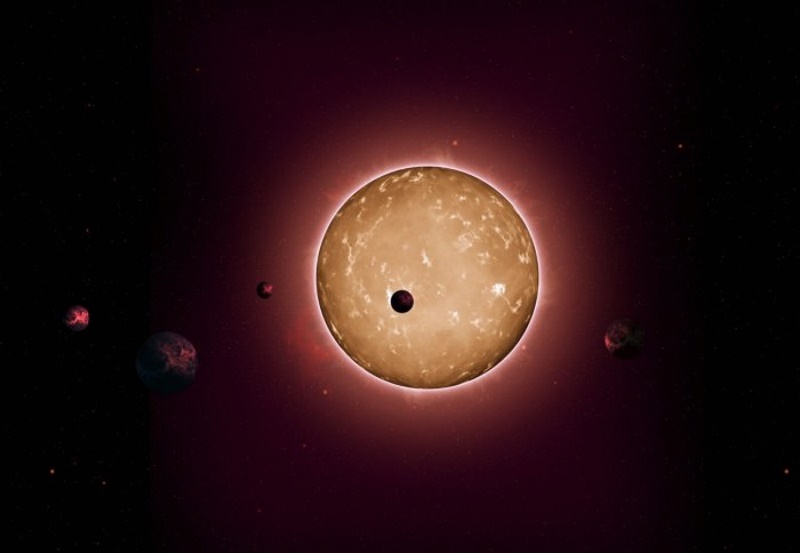- Home
- Science
- Science News
- Not Many 'Habitable' Planets Can Harbour Life: Study
Not Many 'Habitable' Planets Can Harbour Life: Study

The study suggests that although they orbit smaller and dimmer stars, many of these planets might still be too hot to be habitable.
When looking for planets that could harbour life, scientists look for planets in the 'habitable zones' around their stars - at the right distance from the stars to allow water to exist in liquid form.
Traditionally, this search has focused on looking for planets orbiting stars like our Sun, in a similar way to Earth.
However, recent research has turned to small planets orbiting very close to stars called M dwarfs or red dwarfs, which are much smaller and dimmer than the Sun., said the team from Imperial College London and the Institute for Advanced Studies in Princeton.
"It was previously assumed that planets with masses similar to Earth would be habitable simply because they were in the 'habitable zone'. However, when you consider how these planets evolve over billions of years this assumption turns out not to be true," said Dr James Owen from the Institute for Advanced Studies in Princeton.
M dwarfs make up around 75 percent of all the stars in our galaxy and recent discoveries have suggested that many of them host planets, pushing the number of potentially habitable planets into the billions.
This month, both the TRAPPIST and Kepler planet-hunting telescopes have announced the discovery of multiple near-Earth-sized planets orbiting M dwarf stars -- some within the habitable zones.
The scientists suggest that some of the planets might still be habitable, but only those with a smaller mass than Earth, comparable to Venus or Mars.
"There are hints from recent exoplanet discoveries that relatively puny planets may be even more common around red dwarfs than Earth mass or larger ones, in which case there may indeed be a bonanza of potentially habitable planets whirling around these cool red stars," explained Dr Subhanjoy Mohanty from Imperial College London.
It was known previously that many of these planets are born with thick atmospheres of hydrogen and helium, making up roughly one percent of the total planetary mass.
In comparison, the Earth's atmosphere makes up only a millionth of its mass.
The greenhouse effect of such a thick atmosphere would make the surface far too hot for liquid water, rendering the planets initially uninhabitable.
The new analysis reveals that this is not the case. Instead, detailed computer simulations show that these thick hydrogen and helium envelopes cannot escape the gravity of planets that are similar to or larger in mass than the Earth, meaning that many of them are likely to retain their stifling atmospheres.
However, all is not lost, according to the researchers. While most of the M dwarf planets that are Earth-mass or heavier would retain thick atmospheres, smaller planets, comparable to Venus or Mars, could still lose them to evaporation.
The study was published in the journal Monthly Notices of the Royal Astronomical Society.
For the latest tech news and reviews, follow Gadgets 360 on X, Facebook, WhatsApp, Threads and Google News. For the latest videos on gadgets and tech, subscribe to our YouTube channel. If you want to know everything about top influencers, follow our in-house Who'sThat360 on Instagram and YouTube.
Related Stories
- Samsung Galaxy Unpacked 2025
- ChatGPT
- Redmi Note 14 Pro+
- iPhone 16
- Apple Vision Pro
- Oneplus 12
- OnePlus Nord CE 3 Lite 5G
- iPhone 13
- Xiaomi 14 Pro
- Oppo Find N3
- Tecno Spark Go (2023)
- Realme V30
- Best Phones Under 25000
- Samsung Galaxy S24 Series
- Cryptocurrency
- iQoo 12
- Samsung Galaxy S24 Ultra
- Giottus
- Samsung Galaxy Z Flip 5
- Apple 'Scary Fast'
- Housefull 5
- GoPro Hero 12 Black Review
- Invincible Season 2
- JioGlass
- HD Ready TV
- Laptop Under 50000
- Smartwatch Under 10000
- Latest Mobile Phones
- Compare Phones
- Redmi Turbo 4
- Vivo Y200+
- Lava Yuva 2 5G
- OnePlus Ace 5
- OnePlus Ace 5 Pro
- Oppo A5 Pro 5G
- Vivo Y29 5G
- Honor Magic 7 RSR Porsche Design
- Asus Zenbook S 14
- MacBook Pro 16-inch (M4 Max, 2024)
- Honor Pad X9 Pro
- Honor Pad V9
- boAt Enigma Gem
- boAt Enigma Daze
- Sony 65 Inches Ultra HD (4K) LED Smart TV (KD-65X74L)
- TCL 55 Inches Ultra HD (4K) LED Smart TV (55C61B)
- Sony PlayStation 5 Pro
- Sony PlayStation 5 Slim Digital Edition
- Blue Star 1.5 Ton 3 Star Inverter Split AC (IC318DNUHC)
- Blue Star 1.5 Ton 3 Star Inverter Split AC (IA318VKU)

















